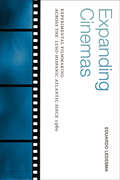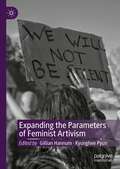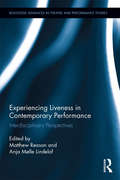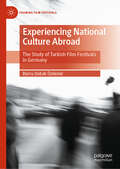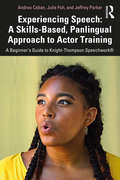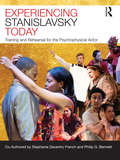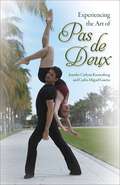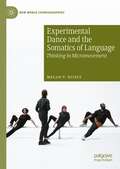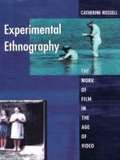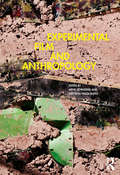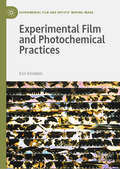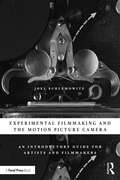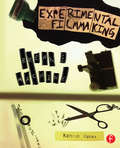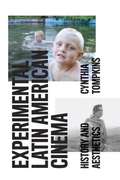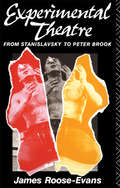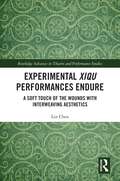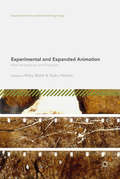- Table View
- List View
Expanding Austenland: The Pride and Prejudice Fanfiction Archive (Palgrave Fan Studies)
by Áine MaddenExpanding Austenland: The Pride and Prejudice Fanfiction Archive explores Jane Austen’s reception in popular culture through an exploration of the ever-expanding terrain of online fanfiction, professionally published (profic) texts, and other intertextual reworkings inspired by the author’s most popular novel, Pride and Prejudice. The book argues that given its pervasiveness, Pride and Prejudice could be usefully considered not as a single novel, but as an entire ‘archive’ of interrelated texts, or as a portal that opens a ‘virtual world’ for readers to expand and explore. By examining the Pride and Prejudice archive of interrelated texts, this book analyses the process through which an individual novel can develop a virtual life, or afterlife. The evolving world that is opened by Pride and Prejudice, and extended and enriched through fanfiction, is conceptualised in the monograph as ‘Austenland’.
Expanding Cinemas: Experimental Filmmaking across the Luso-Hispanic Atlantic since 1960 (SUNY series in Latin American Cinema)
by Eduardo LedesmaThis is the first book on experimental cinemas of Latin American and Spain to offer a comprehensive look at old and new technologies, including Super 8, VHS, cell phones, virtual reality, artificial intelligence, and more. From the militant films of the 1960s to today's expanded reality experiences, filmmakers in Argentina, Spain, Cuba, Colombia, Brazil, and Mexico have continually used alternative formats both to dialogue with international movements and to counter commercial cinematic trends. To make this argument and cover this vast geographic and historical terrain, Eduardo Ledesma adopts a transnational and intermedial approach, examining exchanges and associations between cineastes to better understand how their films were created and circulated. Ledesma works to untangle both the relations between media and the associations of experimental cinema to cultural phenomena such as diaspora, exile, displacement, and immigration. Throughout the book, connections are further made to other global avant-garde and alternative cinemas and formats, including in the United States.
Expanding the Parameters of Feminist Artivism
by Kyunghee Pyun Gillian HannumThis book explores the work and careers of women, trans, and third-gender artists engaged in political activism. While some artists negotiated their own political status in their indigenous communities, others responded to global issues of military dictatorship, racial discrimination, or masculine privilege in regions other than their own. Women, trans, and third-gender artists continue to highlight and challenge the disturbing legacies of colonialism, imperialism, capitalism, communism, and other political ideologies that are correlated with patriarchy, primogeniture, sexism, or misogyny. The book argues that solidarity among such artists remains valuable and empowering for those who still seek legitimate recognition in art schools, cultural institutions, and the history curriculum.
Experiencing Accents: A Knight-Thompson Speechwork® Guide for Acting in Accent
by Andrea Caban Philip Thompson Tyler SeipleExperiencing Accents: A Knight-Thompson Speechwork® Guide for Acting in Accent presents a comprehensive and systematic approach to accent acquisition for actors. It lays out an accessible and effective set of tools, exercises, and theoretical frameworks grounded in current linguistic science, as well as more than two decades of teaching, actor training, and coaching developed by Knight-Thompson Speechwork®. This book dismantles the notions that accents exist on a spectrum of good and bad or that "neutral," "general," or "standard" can serve as ideals for speech. By de-centering elitist and authoritarian worldviews, it gives actors a path to mobilize their innate language abilities to acquire any accent, relying on descriptive and experiential knowledge. The innovative approach of the Four Ps – People, Prosody, Posture, and Pronunciation – builds cultural competence that honors accents as they exist in the world, increases the physical and perceptive skills of the actor, and provides a rich variety of applications to encourage fluid and embodied accent performance. Each of the Four Ps are investigated and practiced separately and then synthesized in the art of the performer, allowing actors to address the complexity of acting in accent through a deliberate and sequential layering of skills, rendering the final expression of their technique meticulously accurate and deeply authentic. Organized into fifteen modules to correspond with a typical semester, Experiencing Accents is perfect for Theatre students in voice, speech, and accents courses, along with working actors interested in improving their accent work.
Experiencing Dance: From Student to Dance Artist
by Helene Scheff Marty Sprague Susan Mcgreevy-NicholsIn this text for students who have had some experience in dance, Scheff, a dance educator, presents 45 self-paced lessons, plus guidelines for building a portfolio, that will help students understand dance as an art form, create and perform dances, evaluate and critique dance, and understand cultural influences on dance. Each chapter includes objectives, three or four lessons, portfolio items, and a quiz. The book offers a complete curriculum progression that can also be used to supplement an existing curriculum. B&w photos and drawings are included. There is no subject index. Annotation ©2004 Book News, Inc. , Portland, OR (booknews. com)
Experiencing Liveness in Contemporary Performance: Interdisciplinary Perspectives (Routledge Advances in Theatre & Performance Studies)
by Matthew Reason Anja Mølle LindelofThis volume brings together dynamic perspectives on the concept of liveness in the performing arts, engaging with the live through the particular analytical focus of audiences and experience. The status and significance of the live in performance has become contested: perceived as variously as a marker of ontological difference, a promotional slogan, or a mystical evocation of cultural value. Moving beyond debates about the relationship between the live and the mediated, this collection considers what we can know and say about liveness in terms of processes of experiencing and processes of making. Drawing together contributions from theatre, music, dance, and performance art, it takes an interdisciplinary approach in asking not what liveness is, but how it matters and to whom. The book invites readers to consider how liveness is produced through processes of audiencing - as spectators bring qualities of (a)liveness into being through the nature of their attention - and how it becomes materialized in acts of performance, acts of making, acts of archiving, and acts of remembering. Theoretical chapters and practice-based reflections explore liveness, eventness and nowness as key concepts in a range of topics such as affect, documentation, embodiment, fandom, and temporality, showing how the relationship between audience and event is rarely singular and more often malleable and multiple. With its focus on experiencing liveness, this collection will be of interest to disciplines including performance, audience and cultural studies, visual arts, cinema, and sound technologies.
Experiencing Music Video: Aesthetics and Cultural Context
by Carol VernallisHere at last is a study that treats music video as a distinct multimedia artistic genre, different from film, television, and indeed from songs themselves. Carol Vernallis describes how musical, visual and verbal codes work together in music video and reveals modes of representing race, class, gender, and sexuality that characterize the music video form.
Experiencing Music Video: Aesthetics and Cultural Context
by Carol VernallisMusic videos have ranged from simple tableaux of a band playing its instruments to multimillion dollar, high-concept extravaganzas. Born of a sudden expansion in new broadcast channels, music videos continue to exert an enormous influence on popular music. They help to create an artist's identity, to affect a song's mood, to determine chart success: the music video has changed our idea of the popular song.Here at last is a study that treats music video as a distinct multimedia artistic genre, different from film, television, and indeed from the songs they illuminate—and sell. Carol Vernallis describes how verbal, musical, and visual codes combine in music video to create defining representations of race, class, gender, sexuality, and performance. The book explores the complex interactions of narrative, settings, props, costumes, lyrics, and much more. Three chapters contain close analyses of important videos: Madonna's "Cherish," Prince's "Gett Off," and Peter Gabriel's "Mercy St."
Experiencing National Culture Abroad: The Study of Turkish Film Festivals in Germany (Framing Film Festivals)
by Burcu Dabak ÖzdemirImmigrant film festivals are multifaceted events where complex networks of identities and symbolic values are constructed, circulated, and debated through various channels, including program screenings, ancillary events, press releases, financial backing, and audience engagement. As such, immigrant film festivals can be seen as discourse-producing practices. Based on this idea, this book offers a comprehensive study of three prominent Turkish film festivals in Germany: the International Frankfurt Turkish Film Festival, the Nuremberg Turkey/Germany Film Festival, and the Munich Turkish Film Days. The overarching objective is to comprehend the multifaceted influence of these festivals on the construction of discourses on Turkish immigrant identity while also seeking to illuminate how these festivals reshape both the host country and the country of origin and produce ideas for Turkish immigrants This is achieved through an examination of the diverse representation strategies engendered by these festivals. By employing a multifaceted research approach—including content analysis, audience studies, semi-structured interviews with festival managers, and participant observation—this study seeks to provide a nuanced understanding of the complex interplay between immigrant film festivals, cultural identity formation, and the socio-political dynamics within both the host and origin countries. Through rigorous scholarly inquiry, it aims to contribute to academic discourse on the role of film festivals in shaping cultural narratives, fostering intercultural dialogue, and facilitating processes of integration and belonging within immigrant communities.
Experiencing Speech: A Beginner's Guide to Knight-Thompson Speechwork®
by Jeffrey Parker Andrea Caban Julie FohExperiencing Speech: A Skills-Based, Panlingual Approach to Actor Training is a beginner’s guide to Knight-Thompson Speechwork®, a method that focuses on universal and inclusive speech training for actors from all language, racial, cultural, and gender backgrounds and identities. This book provides a progression of playful, practical exercises designed to build a truly universal set of speech skills that any actor can use, such as the ability to identify, discern, and execute every sound found in every language on the planet. By observing different types of flow through the vocal tract, vocal tract anatomy, articulator actions, and how these components can be combined, readers will understand and recreate the process by which language is learned. They will then be introduced to the International Phonetic Alphabet (IPA) and will practice using the IPA for narrow transcription of speech sounds. The book also offers both an intellectual and physical understanding of oral posture and how it contributes to vocal characterization and accent work. This approach to speech training is descriptive, giving students a wide and diverse set of speech sounds and skills to utilize for any character in any project, and it establishes a foundation for future accent study and acquisition. Experiencing Speech: A Skills-Based, Panlingual Approach to Actor Training is an excellent resource for teachers and students of speech and actor training, as well as aspiring actors looking to diversify their speech skills.
Experiencing Stanislavsky Today: Training and Rehearsal for the Psychophysical Actor
by Stephanie Daventry French Philip G. BennettThis pioneering introduction to Stanislavsky's methods and modes of actor training covers all of the essential elements of his System. Recreating 'truthful' behaviour in the artificial environment, awareness and observation, psychophysical work, given circumstances, visualization and imagination, and active analysis are all introduced and explored. Each section of the book is accompanied by individual and group exercises, forming a full course of study in the foundations of modern acting. A glossary explains the key terms and concepts that are central to Stanislavsky's thinking at a glance. The book's companion website is full of downloadable worksheets and resources for teachers and students. Experiencing Stanislavsky Today is enhanced by contemporary findings in psychology, neuroscience, anatomy and physiology that illuminate the human processes important to actors, such as voice and speech, creativity, mind-body connection, the process and the production of emotions on cue. It is the definitive first step for anyone encountering Stanislavsky's work, from acting students exploring his methods for the first time, to directors looking for effective rehearsal tools and teachers mapping out degree classes.
Experiencing the Art of Pas de Deux
by Jennifer C. Kronenberg Carlos M. Guerra"An insightful read from one of the ballet world’s most beloved married couples!"--Melinda Roy, former principal dancer, New York City Ballet "Wonderfully complete and instructive, written by two artists who have lived what they write about and are sharing their life experience from a deep and very human viewpoint. Bravo!"--Donald Mahler, former director, Metropolitan Opera Ballet "Perfect for inspiring dancers who want to learn more about the art of partnering."--Lauren Jonas, cofounder and artistic director, Diablo Ballet "An effective and lively resource to add to a dancer and teacher’s partnering skills toolkit."--Dean Speer, author of On Technique Traditionally, the pas de deux was designed as an interlude during longer ballets and showcased a ballerina’s skills. The male was a guide to her movements and steps, an unwavering extension of the ballerina. Today the pas de deux occupies a central role in dances and the reliance on a male’s strength has given way to endless modifications. Respect, patience, intuition, and awareness are just as significant as technique and the best partners communicate through breath, eye contact, and musical cues. In Experiencing the Art of Pas de Deux, professional dance couple Jennifer Carlynn Kronenberg and Carlos Miguel Guerra demystify the physical, emotional, and artistic intricacies that allow two to dance as one. They examine key components often overlooked in classes and textbooks, such as how to build and maintain the connections necessary for a trusting and successful team. Illuminating pas de deux work from both male and female perspectives, they detail the specific responsibilities of each partner. Step-by-step instructions are provided for proper posture, lifts, promenades, turns, and even dance conditioning--and QR code–accessible videos provide brief demonstrations of new and complex movements. Each chapter also includes personal anecdotes, offering a rare and intimate look at how partners can support one another and discover the inner workings of the finest and most memorable dances. Jennifer Carlynn Kronenberg is a former principal dancer with the Miami City Ballet. She has conducted master classes for Ballet Chicago and Ballet de Monterrey, among other companies and schools. She is the author of So, You Want to Be a Ballet Dancer? Carlos Miguel Guerra is a former principal dancer with the Miami City Ballet. He studied and worked with Fernando Alonso in Cuba, Ivan Nagy in Chile, and Edward Villella in Miami.
Experiential Spectatorship: Immersion, Participation, and Play During Times of Deep Mediatization (Audience Research)
by William W. LewisExperiential Spectatorship offers a lens for analyzing audience experience with(in) a variety of contemporary media. Using a broad-based perspective, this media includes participatory theatre, video games, digital simulations, social media platforms, alternate reality games, choose your own adventure narratives, interactive television, and a variety of other experiential performance events. Through a taxonomy that includes Immersion, Participation, Game Play, and Role Play the book guides the reader to understand the ways mediatization and technics brought about by digital technologies are changing the capacities and expectations of contemporary audiences. In their daily interactions and relations with their technologies, they become mediatized spectators. By reading these technologies' impacts on individual subjectivity prior to acts of spectatorship, one gains the tools to best describe how the spectator creates forms of relational exchange with their experential media.This book prepares the reader to think in a digital manner so they can best recognize how performance and spectatorship in the twenty-first century are evolving to meet the needs of future waves of spectators brought up in a postdigital world.
Experimental Dance and the Somatics of Language: Thinking in Micromovement (New World Choreographies)
by Megan V. NicelyThis book is about dance’s relationship to language. It investigates how dance bodies work with the micromovements elicited by language’s affective forces, and the micropolitics of the thought-sensations that arise when movement and words accompany one another within choreographic contexts. Situating itself where theory meets practice—the zone where ideas arise to be tested, the book draws on embodied research in practices within the lineages of American postmodern dance and Japanese butoh, set in dialog with affect-based philosophies and somatics. Understanding that language is felt, both when uttered and when unspoken, this book speaks to the choreographic thinking that takes place when language is considered a primary element in creating the sensorium.
Experimental Ethnography: The Work of Film in the Age of Video
by Catherine RussellExperimental film and ethnographic film have long been considered separate, autonomous practices on the margins of mainstream cinema. By exploring the interplay between the two forms, Catherine Russell throws new light on both the avant-garde and visual anthropology. Russell provides detailed analyses of more than thirty-five films and videos from the 1890s to the 1990s and discusses a wide range of film and videomakers, including Georges Méliès, Maya Deren, Peter Kubelka, Ray Birdwhistell, Jean Rouch, Su Friedrich, Bill Viola, Kidlat Tahimik, Margaret Mead, Tracey Moffatt, and Chantal Akerman. Arguing that video enables us to see film differently--not as a vanishing culture but as bodies inscripted in technology, Russell maps the slow fade from modernism to postmodern practices. Combining cultural critique with aesthetic analysis, she explores the dynamics of historical interruption, recovery, and reevaluation. As disciplinary boundaries dissolve, Russell contends, ethnography is a means of renewing the avant-gardism of "experimental" film, of mobilizing its play with language and form for historical ends. "Ethnography" likewise becomes an expansive term in which culture is represented from many different and fragmented perspectives. Original in both its choice of subject and its theoretical and methodologicalapproaches, Experimental Ethnography will appeal to visual anthropologists, as well as film scholars interested in experimental and documentary practices.
Experimental Film and Anthropology (Criminal Practice Ser.)
by Arnd SchneiderExperimental Film and Anthropology urges a new dialogue between two seemingly separate fields. The book explores the practical and theoretical challenges arising from experimental film for anthropology, and vice versa, through a number of contact zones: trance, emotions and the senses, materiality and time, non-narrative content and montage. Experimental film and cinema are understood in this book as broad, inclusive categories covering many technical formats and historical traditions, to investigate the potential for new common practices. An international range of renowned anthropologists, film scholars and experimental film-makers engage in vibrant discussion and offer important new insights for all students and scholars involved in producing their own films. This is indispensable reading for students and scholars in a range of disciplines including anthropology, visual anthropology, visual culture and film and media studies.
Experimental Film and Photochemical Practices (Experimental Film and Artists’ Moving Image)
by Kim KnowlesThis book assesses the contemporary status of photochemical film practice against a backdrop of technological transition and obsolescence. It argues for the continued relevance of material engagement for opening up alternative ways of seeing and sensing the world. Questioning narratives of replacement and notions of fetishism and nostalgia, the book sketches out the contours of a photochemical renaissance driven by collective passion, creative resistance and artistic reinvention. Celluloid processes continue to play a key role in the evolution of experimental film aesthetics and this book takes a personal journey into the work of several key contemporary film artists. It provides fresh insight into the communities and infrastructures that sustain this vibrant field and mobilises a wide range of theoretical perspectives drawn from media archaeology, new materialism, ecocriticism and social ecology.
Experimental Film and Video
by Stephen Littman Jackie HatfieldThe past 40 years of technological innovation have significantly altered the materials of production and revolutionized the possibilities for experiment and exhibition. Not since the invention of film has there been such a critical period of major change in the imaging technologies accessible to artists. Bringing together key artists in film, video, and digital media, the anthology of Experimental Film and Video revisits the divergent philosophical and critical discourses of the 1970s and repositions these debates relative to contemporary practice. Forty artists have contributed images, and 25 artists reflect on the diverse critical agendas, contexts, and communities that have affected their practice across the period from the late 1960s to date. Along with an introduction by Jackie Hatfield and forewords by Sean Cubitt and Al Rees, this illustrated anthology includes interviews and recent essays by filmmakers, video artists, and pioneers of interactive cinema. Experimental Film and Video opens up the conceptual avenues for future practice and related critical writing.
Experimental Filmmaking and the Motion Picture Camera: An Introductory Guide for Artists and Filmmakers
by Joel SchlemowitzExperimental Filmmaking and the Motion Picture Camera is an introductory guide to experimental filmmaking, surveying the practical methods of experimental film production as well as the history, theory, and aesthetics of experimental approaches. Author Joel Schlemowitz explains the basic mechanism of the camera before going on to discuss slow and fast motion filming, single-frame time lapse, the long take, camera movement, workings of the lens, and the use of in-camera effects such as double exposure. A comprehensive guide to using the 16mm Bolex camera is provided. Strategies for making films edited in-camera are covered. A range of equipment beyond the basic non-sync camera is surveyed. The movie diary and film portrait are examined, along with the work of a range of experimental filmmakers including Stan Brakhage, Rudy Burckhardt, Paul Clipson, Christopher Harris, Peter Hutton, Takahiko Iimura, Marie Losier, Rose Lowder, Jonas Mekas, Marie Menken, Margaret Rorison, Guy Sherwin, and Tomonari Nishikawa. This is the ideal book for students interested in experimental and alternative modes of filmmaking. It provides invaluable insight into the history, methods, and concepts inherent to experimental uses of the camera, while providing students with a solid foundation of techniques and practices to foster their development as filmmakers. Supplemental material, including links to films cited in the book, can be found at www.experimentalfilmmaking.com.
Experimental Filmmaking: Break the Machine
by Kathryn RameyExperimental Filmmaking emerges out of a deep and abiding love of celluloid and artisanal media practices and a personal exploration of the field of avant-garde and experimental film, animation and video produced since the beginnings of cinema. Although there have been many critical and historical books on the subject, with the exception of zines and hand-published volumes, there has never been a comprehensive instructional manual on experimental processes. This book will introduce film students and professional filmmakers alike to various methods of experimental animation, film and video production that involve material interventions into the normative process of the medium while offering brief introductions to artists and their works.
Experimental Latin American Cinema: History and Aesthetics
by Cynthia TompkinsWhile there are numerous film studies that focus on one particular grouping of films—by nationality, by era, or by technique—here is the first single volume that incorporates all of the above, offering a broad overview of experimental Latin American film produced over the last twenty years. Analyzing seventeen recent films by eleven different filmmakers from Argentina, Brazil, Cuba, Mexico, Paraguay, and Peru, Cynthia Tompkins uses a comparative approach that finds commonalities among the disparate works in terms of their influences, aesthetics, and techniques. Tompkins introduces each film first in its sociohistorical context before summarizing it and then subverting its canonical interpretation. Pivotal to her close readings of the films and their convergences as a collective cinema is Tompkins’s application of Deleuzian film theory and the concept of the time-image as it pertains to the treatment of time and repetition. Tompkins also explores such topics as the theme of decolonization, the consistent use of montage, paratactically structured narratives, and the fusion of documentary conventions and neorealism with drama. An invaluable contribution to any dialogue on the avant-garde in general and to filmmaking both in and out of Latin America, Experimental Latin American Cinema is also a welcome and insightful addition to Latin American studies as a whole.
Experimental Theatre: From Stanislavsky to Peter Brook
by James Roose-Evans`It is a pleasure to read. Well-written, free of cant, impressively wide-ranging. The book is really an introduction to the avant-garde.' - John Lahr
Experimental Xiqu Performances Endure: A Soft Touch of the Wounds with Interweaving Aesthetics (Routledge Advances in Theatre & Performance Studies)
by Lin ChenThis book offers a detailed, comprehensive, and theoretically grounded study of experimental xiqu performances that have taken place in recent decades across Mainland China, Hong Kong, Taiwan and online platforms.Situating these performances within their specific socio-political contexts and historical trajectories, this book explores the question, what defining aesthetics and methodologies characterise experimental xiqu practices, and how do they distinguish themselves from traditional xiqu aesthetics and the ‘intercultural theatre’ paradigm epitomised by the ‘Western story, Eastern body’ approach? A performative theoretical framework is developed to facilitate a thorough examination of the evolution of xiqu from the last millennium to modern times, with particular focus on the 20th century. The primary objectives of this investigation are twofold: to establish a nuanced understanding of the dynamic and non-dualistic concept of ‘traditional xiqu’, and to provide a vivid depiction of the diverse soils shaping various experimental xiqu performances. Focusing on aesthetics, this book further conducts detailed performance analyses of The Outcast General, Metamorphosis, Sighing and The Spirits Play Online. This book contends that experimental xiqu performances reveal the deep wounds borne by a significant number of ordinary people. Owing to the discourse of ‘beauty’ surrounding xiqu, the institutional constraints, the dualistic political discourses and, most of all, the as-yet-unconstructed condition of collective cultural trauma within these contexts, all the wounds are touched ‘softly’. Experimental xiqu performances help endure the deep wounds and the unarticulated cultural traumas.This book will be of great interest to theatre, performance and opera studies scholars and students.
Experimental and Expanded Animation: New Perspectives and Practices (Experimental Film and Artists’ Moving Image)
by Vicky Smith Nicky HamlynThis book discusses developments and continuities in experimental animation that, since Robert Russet and Cecile Starr’s Experimental Animation: Origins of a New Art (1976), has proliferated in the context of expanded cinema, performance and live ‘making’ and is today exhibited in galleries, public sites and online. With reference to historical, critical, phenomenological and inter-disciplinary approaches, international researchers offer new and diverse methodologies for thinking through these myriad animation practices. This volume addresses fundamental questions of form, such as drawing and the line, but also broadens out to encompass topics such as the inter-medial, post-humanism, the real, fakeness and fabrication, causation, new forms of synthetic space, ecology, critical re-workings of cartoons, and process as narrative. This book will appeal to cross and inter-disciplinary researchers, animation practitioners, scholars, teachers and students from Fine Art, Film and Media Studies, Philosophy and Aesthetics.
Experiments in Immersive, One-to-One Performance: Understanding Audience Experience through Sensory Engagement (Audience Research)
by Natalia EslingThis book investigates audience experience through the lens of sensory engagement in immersive, one-to-one performance. It presents a distinct, practice-based research (PBR) framework – a performance research ‘laboratory’ – designed to evaluate the effects on diverse audience experiences of two ‘sense-specific manipulations’: eye masks and touch. Through a qualitative analysis of responses from seventy-four individual audience participants, this book offers insight into how these popular ‘immersing’ strategies might be experienced. What do these strategies achieve? How do audience participants make sense of them? Do audience responses align with artistic intentions? And how does the PBR framework designed to address these questions influence the outcomes? Through an analysis of three sets of one-to-one performance experiments generating comparative data about the experience of sense-specific manipulation, this book proposes the utility of merging methodologies in artistic research with empirical audience research in theatre and performance studies. This study offers a new perspective on the value of sensory-focused, immersive, one-to-one experience as a means of resensitizing audience participants through performance.

